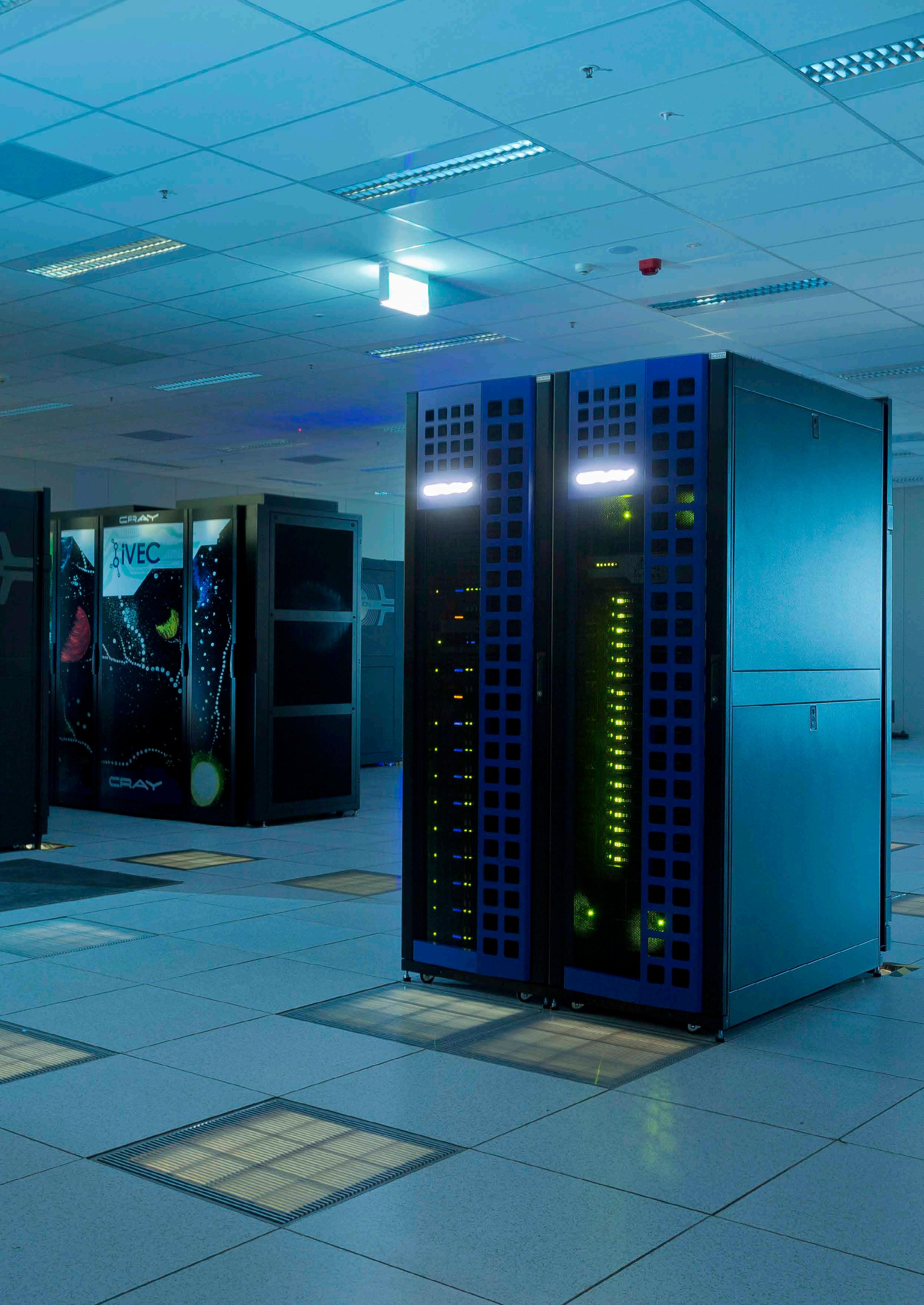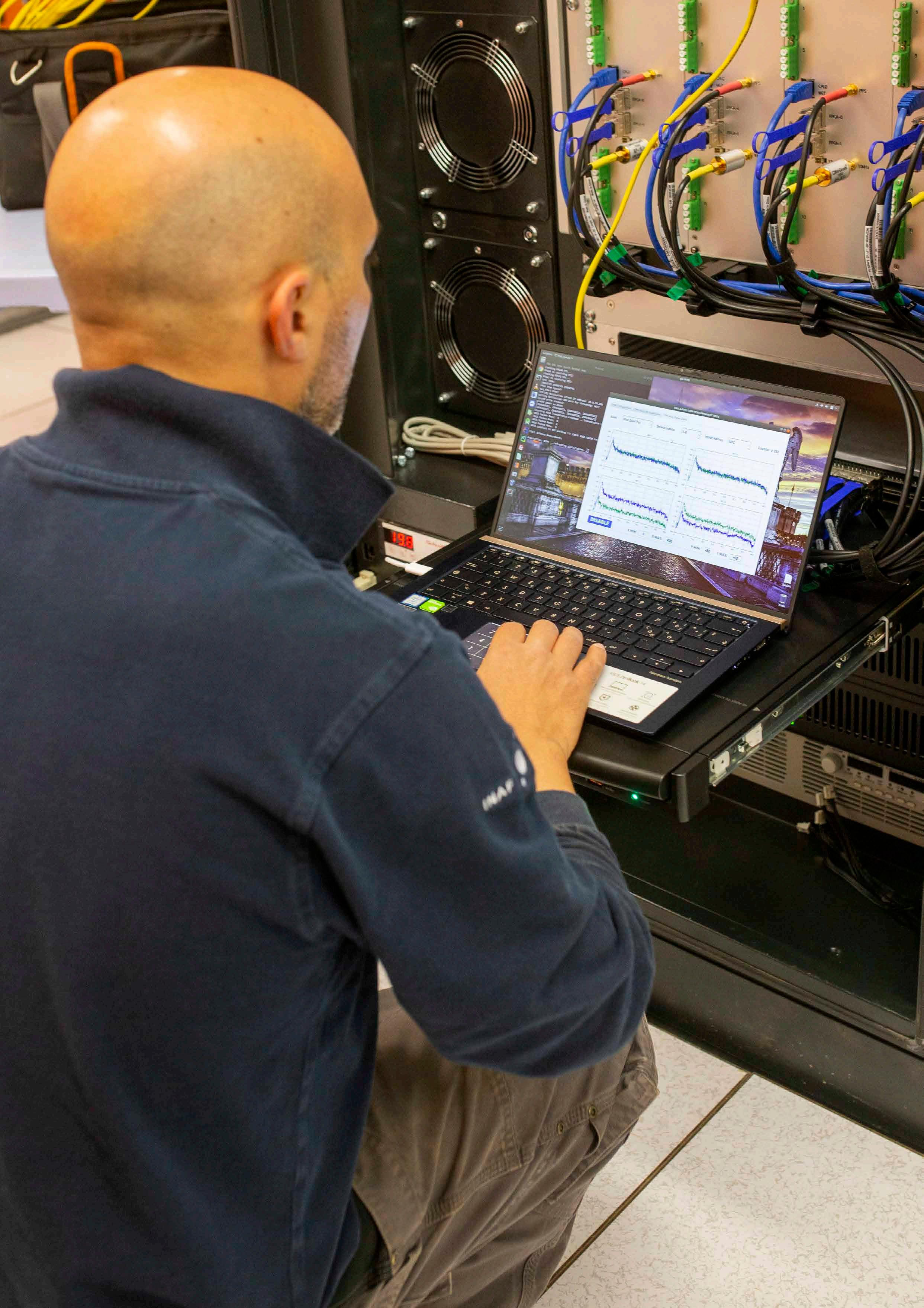August 2024



August 2024


The Department of Jobs, Tourism, Science and Innovation acknowledges the Traditional Custodians throughout Western Australia and their continuing connection to the land, waters and community. We pay our respects to all members of the Aboriginal communities and their cultures; and to Elders both past and present.
Western Australia has thriving businesses and industries that are digitally secure, enabled and empowered
Western Australia is the proud home of over 240,0001 businesses employing over 1.5 million2 people. Our economy presents a wealth of opportunities. To ensure our ongoing prosperity we need to sustainably grow and diversify, establishing a wide range of strong industries providing stable, well-paid employment across our regions. We navigate this challenge in a constrained environment - with ever-growing demand for labour, interconnectedness, and increased sustainability.
Productivity improvements facilitated by technological developments will allow us to achieve more with local skills and resources and to do it in a way that leaves a sound environment for our future generations. Digitally enabled and empowered Western Australian businesses and industries will help us chart a course to a resilient, competitive economy. We are already world leaders in remote operation technology and are developing technology transfer across industries. Building new areas of expertise from our existing advantages will help to establish a framework for ongoing success.
Our mission is to drive economic growth and diversification by accelerating the digital transformation and uplift of Western Australian businesses and industries.

In an era of economic and geopolitical change it is essential that our State continues to develop our capabilities and attract investment to sustain the economic growth that has allowed us to prosper. We need to be ready to capitalise on the opportunities of tomorrow and to rise and meet challenges along the way.
We have strong foundations to build on – a skilled workforce, stable government, and excellent infrastructure. If we are adaptive, creative and embrace technology we can lay stronger foundations for the years to come. Digital innovation presents Western Australian industries with unrivalled opportunities for growth and development, unlocking more of our vast state and enabling home-grown businesses to compete on the global stage.
Directly aligning with and supporting the Government’s economic framework Diversify WA, this strategy lays the foundation for digital transformation and technological uplift of businesses across a variety of industries underpinning the productivity, competitiveness, and resilience of the State’s economy. Digital solutions allow Government and business to improve accessibility and inclusivity, providing better services to all members of the community.
Government must be an agile and responsive partner in the digital evolution of business and industry. It will take all elements of the digital ecosystem to achieve our vision for the State. Together, we can place Western Australia at the forefront of digital transformation, delivering a sustainable future for generations to come.
In recognition of the pace of digital transformation, this strategy will be published online along with a hub of information to assist in the digital acceleration of businesses and industries statewide.
By supporting the digitalisation of business and industry, along with our promising digital sector, we are demonstrating our commitment to a diverse, resilient, and sustainable economy for the future.
Hon Stephen Dawson MLC Minister for Innovation and the Digital Economy

Figure 1: Digital Industries Acceleration Strategy Framework
Vision
Western Australia has thriving businesses and industries that are digitally secure, enabled and empowered
Mission
To accelerate the digital transformation and uplift of Western Australian businesses and industries
3 Goals
ARROW-UP-RIGHT-DOTS CHART-NETWORK LOCATION-DOT
WA has a growing and vibrant digital sector
5 Priority Action Areas
WA businesses continuously evolve in digital capability
WA industries transform through embracing digital
USERS-CLASS Advocacy and education Advisory and technical support Finance and supply opportunities
Data and digital facility sharing Opportunity facilitation
Digital transformation has become a fundamental driver of change in our constantly evolving world. As the Fourth Industrial Revolution unfolds, soaring flows of data and information now generate more economic value than the global goods trade3 . Digital technology touches all aspects of society 4 and presents an unrivalled opportunity to create a sustainable, inclusive future.5 This is particularly important to ensuring an equitable standard of living in a state as remote and sparsely populated as Western Australia.
The Organisation for Economic Cooperation and Development (OECD) highlights that digital transformation affects economies and societies in complex and interrelated ways, demanding more strategic approaches, particularly in the context of emerging digital technologies such as Artificial Intelligence (AI). Further, rapid development and adoption of digital technologies is essential to achieving global emissions targets and limiting the impact of climate change. Western Australia is well positioned to lead in this area.
Digital enablement is increasingly important for all businesses that are part of a supply chain. Businesses that do not keep pace with relevant technologies risk becoming isolated and unable to compete as part of increasingly complex supply chains for both goods and services. Research shows that highly digitally engaged businesses earn 60 per cent more revenue per employee and grow 28 per cent faster than businesses with poor digital engagement.6
Digital technology continues to transform business in new and unexpected ways. From AI to quantum computing, autonomous vehicles, and the Internet of Things (IoT), there is seemingly limitless potential. While we must be mindful of how we implement these technologies, they provide the capability to address intricate challenges on an unprecedented scale.
While digital technologies are an enabler across industries, Western Australia’s emerging digital sector is making meaningful economic contributions of its own and offers significant opportunities for the future. In 2022, Western Australia’s digital sector and their providers generated an estimated $7.3 billion in value add, and $431 million in direct export sales7. This sector employs over 60,000 workers, and its workforce is growing 2.6 times faster than WA’s total workforce.8
There are many different definitions of the digital economy available11, and one of the most widely adopted is proposed by The Organisation for Economic Co-operation and Development (OECD)12: “The Digital Economy incorporates all economic activity reliant on, or significantly enhanced by the use of digital inputs, including digital technologies, digital infrastructure, digital services and data. It refers to all producers and consumers, including government, that are utilising these digital inputs in their economic activities”.
Western Australia’s approach to the digital economy is based on three pillars (see Figure 2, on the next page):

Pillar 1: Digital government
Access to digital infrastructure supported by appropriate data and digital governance underpins the digital economy and is primarily the responsibility of Government. The Digital Strategy for the Western Australian Government 2021-2025 was developed with the aim of changing the way the community and government interact. It puts Western Australian people, businesses and communities at its centre and sets the vision for a government that provides convenient and secure online services informed by quality data insights.
Pillar 2: Digital society
The Digital Inclusion in Western Australia Blueprint outlines a comprehensive strategy to ensure that all citizens have equal access to digital technologies and the skills needed to fully participate in the digital economy and society. It reflects the Western Australian Government’s commitment to ensuring all citizens can benefit from the digital age, regardless of their background or circumstances. By addressing barriers to digital inclusion and empowering individuals with skills and resources, the government seeks to create a more equitable and prosperous society for all Western Australians.
Pillar 3: Digital industries acceleration
The third pillar, or missing link, is a strategy focused on digital uplift of business and industry.
WA: Digitally Evolved has been developed to address this gap, supporting the growth of the local digital sector and the adoption of digital technologies across the State economy.
The importance of sustainable economic growth in driving improved outcomes cannot be overstated. A productive, growing economy will ensure ongoing prosperity and is the key to positive social impacts. With the right enabling environment, a strong and diverse economy underpins the creation of well-paid jobs, better living standards and improved social outcomes across the State. In addition, digital technologies support Government objectives by accelerating the spread of information across social and geographical divides and facilitating the provision of more equitable services to citizens in remote and regional areas.

Diversify WA provides a blueprint to a more diversified economy that builds on the State’s existing competitive strengths. The uptake of digital technologies and processes is core to the ongoing improvement of all cross-sector activities and priority sectors in Diversify WA (Figure 3, below).

Future State supports the objectives of Diversify WA by setting out the investment needed to unlock opportunities and accelerate the path to economic diversification. It provides a targeted, holistic approach to enabling Western Australian industry to become more resilient, sustainable, and diversified. Digital technology will underpin key advances across these opportunities and sectors.
WA: Digitally Evolved does not work in isolation. It has been designed to complement and connect with a range of economy wide and industry-specific strategies that support Diversify WA (see Figure 4, on page 13). These connections exemplify the work that it is happening across the Western Australian Government to support growth and diversification of the economy.
Figure 4: Complementary strategies to the Digital Industries Acceleration Strategy
Digital industries acceleration strategy
Vision: Western Australian has thriving businesses and industries that are digitally secure, enabled and empowered
WA has a growing and vibrant digital sector
WA businesses continuously evolve in digital capability
WA industries transform through embracing digital
Enablers & related supporting strategies
Digital society
• Digital inclusion blueprint
Digital government
• Digital government strategy
• WA industry participation strategy
Digital skills & workforce
Complementary industry strategies
WA health digital strategy ‘20-30
Health and medical life sciences industry strategy
WA defence and defence industries strategic plan
Geoscience data transformation strategy
Space industries strategy
Advanced manufacturing prospectus
Digital connectivity & infrastructure
• State infrastructure strategy
• Science and technology plan ARROW-UP-RIGHT-DOTS NETWORK-WIRED BRAIN-CIRCUIT ROAD-CIRCLE-CHECK
• DTWD strategic plan ‘23-28
• STEM skills strategy & mission update
• State digital connectivity plan
Science, technology, & innovation
• WA innovation strategy
Western Australia is renowned for its natural resources and enviable lifestyle, but there are a range of other reasons we are a great place to do business.
Western Australia shares a time zone (plus or minus 2 hours) with over 60 per cent of the world’s population including most of our key economic partners in China, Japan, South Korea and Singapore. Additionally, Perth is the only Australian capital city that has core business hours overlapping with Europe and the UK. We are well connected both nationally and internationally with subsea cables providing direct access to Southeast Asia, the Middle East, Europe and Sydney. These high capacity, low latency cable systems make the State an attractive investment location for providers of digital infrastructure and services such as data centres.
As the nation’s economic powerhouse, we understand the global nature of digital supply chains and are committed to supporting local businesses in accessing both national and international markets. We have a stable regulatory environment, extensive network of overseas offices, and a dedicated ‘front door’ for both potential exporters and interested investors in Invest and Trade WA. In addition to being the home to a number of Australia’s resource giants, there are major international digital providers with established operations in Western Australia, including Microsoft, Cisco, IBM and Amazon Web Services.
Digital infrastructure, particularly high-end technology supporting AI and machine learning, is energy intensive, with one study 9 suggesting that the carbon dioxide generated by training a large-scale AI model is equivalent to that generated by five cars over their lifetime. Western Australia’s lower cost energy and green energy potential makes it an ideal location for energy intensive digital businesses. A vast land mass and the world leading solar and wind resources underpin Western Australia’s significant renewable energy potential. This potential is being realised through the Energy Transition Strategy.


Western Australia is home to leading high performance computing (HPC) facilities such as the Pawsey Supercomputing Research Centre (Pawsey) and DUG Technology. Pawsey has been officially recognised as having the most powerful research supercomputer in the southern hemisphere, as well as one of the greenest. Meanwhile, DUG has a patented immersion cooling solution and its proposed data centre in Geraldton will be the world’s first carbon-free HPC facility and amongst the largest in the world.
Western Australia is also the designated home of SKA-Low, part of the Square Kilometre Array (SKA), a global megascience project aimed at building the world's largest and most sensitive radio telescope. The SKA telescope in Western Australia’s Murchison region is designed to explore the universe in unprecedented detail.
Western Australia is regarded as a world leader in remote operations, with the resources sector driving and adopting technologies in relation to automation, robotics, and advanced data analytics. There are similarities between the challenges facing space technologies and those experienced by many sectors on earth. Western Australia’s global reputation in remote operations capability has attracted several staff from NASA in the US to relocate to Perth. WA is home to the Australian Remote Operations for Space and Earth (AROSE) Consortium, the Australian Space Automation AI and Robotics Control Complex (SpAARC) and the Australian Automation and Robotics Precinct (AARP).
Cybersecurity incidents pose significant risks to businesses and the overall economy, as resulting disruptions and financial losses tend to reverberate across organisations. As cyber threats rapidly evolve, incidents have grown more sophisticated, frequent, and increasingly damaging.
Edith Cowan University (ECU) in Perth is a world-leader in cyber security research and education, recognised by the Australian Government as an Academic Centre of Cyber Security Excellence. ECU is home to:
• The national Cyber Security Cooperative Research Centre, which helps grow Australia’s capability in cyber security and deliver solutions to ensure the safety of Australian businesses online.
• The southern hemisphere’s largest university Security Operations Centre, which provides students with real world training in monitoring, detecting, and responding to cyber security threats.
The rapid growth in demand for skilled digital workers is outstripping supply globally, with the impact being more acutely felt by small to medium enterprises. Attraction, development and retention of relevant expertise is crucial to maintaining pace with the evolving digital landscape. There are a number of population segments including women and aboriginal people that are currently underrepresented in the digital workforce. Improving the diversity and accessibility of the sector will provide businesses with access to a broader range of skills and more diverse perspectives fostering inclusivity, creativity and innovation.
While not the focus of this strategy, the importance of improving digital connectivity and access in our regions will impact our ability to achieve our vision. The State has committed $48.6 million to co-invest with the Australian Government, in regional digital connectivity, including under the national Regional Connectivity Program and the national Mobile Network Hardening Program.
Digital connectivity across Western Australia will be further addressed in the forthcoming State Digital Connectivity Plan. The Plan is intended to guide the State’s long-term, strategic investment in digital connectivity, including a prioritisation framework to expand and improve service quality, and digital inclusion outcomes for all citizens and businesses in Western Australia.
Often referred to as the new gold10, the vast amounts of data generated through electronic communication, e-commerce and web-based activity hold great value potential for those who can utilise it effectively. Data analytics and AI offer businesses the ability to better understand customer preferences, optimise operations, and develop new products and services tailored to market demands. However, like most computer-based models, an AI engine is only as useful as its underlying data. If the input data is of poor quality, incomplete, inaccurate or poorly structured the resulting output or analysis will also be flawed or unreliable. Government needs to enable the responsible adoption of AI, allowing businesses to invest with confidence while providing appropriate safeguards to protect citizens’ data.

Our goals under this strategy are simple:
WA has a growing and vibrant digital sector.
Providing the environment in which Western Australia’s digital sector can flourish.
Western Australia’s digital sector has the capacity to address pressing societal challenges in areas including healthcare, education, transportation, and environmental sustainability. By supporting the development of the digital sector, we can drive innovative solutions to these challenges, leading to better public services, improved social welfare and sustainable development.
WA businesses continuously evolve their digital capability.
Enabling businesses in Western Australia to use the digital environment to drive growth, productivity and employment.
Incremental improvements across many firms, resulting from the adoption of even foundational technologies, can make a significant impact to State productivity. Doing this continually enables businesses to stay ahead of the competition and meet evolving customer needs. Embracing continuous improvement through agility and responsiveness will fuel the ongoing prosperity and sustainability of our State.
Digital evolution within and technology transfer between Western Australian industries supports the ongoing growth and diversification of the economy.
Digital technologies are known to deliver significant spillovers of knowledge into other areas of the economy. Western Australia has been at the forefront of digital uplift in the mining sector; from remote operations to geological mapping and safety equipment. By harnessing these technologies and applying to a broader range of industries we can garner global competitive advantages across the economy, supporting economic growth, diversification and jobs.
Digital technologies possess the flexibility to permeate various sectors and regions worldwide, offering effective problem-solving tools that transcend national and industrial borders.

The Western Australian Government has a proud history of providing infrastructure and incentives to support the development of business and industry in the State. At this time of unprecedented change, it is essential that we provide the physical and policy frameworks to deliver the economic growth and stable jobs that are essential for our way of life.
While digital transformation has predominantly been market-driven, there is a role for Government to promote and support the uptake of digital capabilities to support local economic development. This is particularly true at a time when geopolitical technology rivalry is reshaping global supply chains and increasing the focus on sovereign capability. Government can also catalyse digital transformation through the provision of digital services, leading or mandating digital approaches and facilitating connections and technology transfer between industry sectors. This ongoing sharing of information will create changes to the digital landscape.
Achieving our digital goals will be a collaborative effort involving government, industry and academia. Partnering with innovation hubs, business support bodies and existing service providers is central to the success of this Strategy. By leveraging expertise and resources already working in this area the State can provide the best value for money for the people of Western Australia.

Our actions under this strategy are focused on 5 priority areas:
Priority area 1: Advocacy and education
Building awareness of the importance of digital transformation and the capability of businesses to use digital technologies and data.
Priority area 2: Advisory and technical support
Providing access to guidance and support to businesses.
Priority area 3: Finance and supply opportunities
Improving access to government supply contracts and assisting businesses to overcome the barrier of technology cost.
Priority area 4: Data and digital facility sharing
Facilitating responsible sharing of data and providing common-user access to digital infrastructure and piloting facilities.
Priority area 5: Opportunity facilitation
Propelling businesses to take advantage of opportunities and promote the capabilities of Western Australia to the world.
The Australian Productivity Commission’s 5-year Inquiry report, published in March 2023, found that limited awareness and uncertainty about costs and benefits are amongst the most common barriers to technology and adoption by businesses. Promoting the benefits of and facilitating access to timely, relevant information is as important as investments in education and training.
Fee-free TAFE and vocational education and training
In partnership with the Australian Government, the Western Australian Government offers fee-free TAFE and VET training including in information technology and digital disciplines. These courses range from basic digital literacy skills through to Certificate IV and Diploma level. The Digital Workplace Job Ready is an opportunity to gain valuable entry-level skills and links with employers to help participants enter the digital workforce.
STEM skills strategy and mission update
The STEM skills strategy was first released by the Western Australian Government in May 2019. The Mission Update proposes "To grow and bolster a diverse and inclusive, industry-connected STEM education and skills talent pool in Western Australia”. A suitably skilled workforce is essential to the digital transformation of business’ in the State.
Supported by the Western Australian Government, Scitech’s purpose is to “Inspire engagement by all Western Australians in science, technology, engineering and mathematics”. For over 30 years Scitech has brought engaging science experiences to everyone from adventure-ready kids to inquisitive adults, including a range of digital offerings such as podcasts and YouTube series.
What we will do:
In partnership with local industry, we will develop a range of promotional material that:
• Demystify digital transformation;
• Demonstrate the benefits and ease of adopting digital technologies; and
• Showcase a variety of local achievements in both digital adoption and the digital sector.
The material may include fact sheets, short video content, case studies and webinars.
Why?
The process of digital acceleration can be intimidating for business, but the benefits are significant. Sharing real life stories of businesses that have undertaken digital transformation, along with homegrown examples of successful digital businesses can ease the anxiety faced by business owners, developers and prospective entrepreneurs.
What we will do:
In collaboration with partners across Government and industry we will increase the visibility of a range of appropriate learning and training options to promote enhanced digital literacy across the workforce.
Why?
There is an array of education resources available across the variety of digital disciplines, but finding the right one at the right time can be tricky. By identifying and providing access to these resources, many of which are free, we can assist business and the community to gain the skills they need to support digital transformation.
Digital transformation can feel overwhelming, particularly for time-poor small businesses. The ongoing proliferation of digital solutions has made it difficult to determine the best options for a specific business on their digital transformation journey. In addition, finding the time to separate legitimate providers from ‘cowboys’, particularly in an online environment, can be challenging. Enabling better engagement with relevant technologies through expert assistance will accelerate effective digital adoption, including cyber security and artificial intelligence.
Small Business Development Corporation (SBDC)
A State Government agency, the SBDC provides a range of small business support services including advice, online information and business skills workshops designed to help small businesses not only establish well but to survive and thrive.
SBDC Regional
SBDC Regional is a free service funded through the SBDC offering advisory support and workshops to small businesses located throughout regional Western Australia.
Cyber Security Innovation Hub (CyberWest)
Jointly funded by the State Government, Edith Cowan University and the City of Joondalup part of the WA Cyber Security Innovation Hub’s brief is to build awareness of cybercrime and the capability of businesses to both reduce their risk and respond to incidents.
The WADSIH is a State Government initiative, supported by Curtin University, which aims to ensure the State remains at the forefront of the digital revolution by increasing the uptake, education, training and awareness of data science.
WA Creative Tech Innovation Hub (Creative Tech Village)
The WA Creative Tech Innovation Hub is funded by the Western Australian Government in collaboration with Edith Cowan University South West and the City of Bunbury. The Hub works across the State’s regions and focuses on building capability in the creative industries such as design, music, advertising, film, and media, as well as emerging technologies including gaming, digital software development and immersive technology.
WA Life Sciences Innovation Hub
Funded by the State Government, the WA Life Sciences Innovation Hub is accelerating the growth of the State’s MTP (Medtech and Pharm) sector and has a key focus on technology.
The State Government, in collaboration with the Chevron-operated Gorgon Project and funded by the Gorgon Joint Venture, is establishing the GreenTech Hub to support and grow local emerging and established green technology businesses and drive innovation in Western Australia to diversify the economy, create jobs and grow a sustainable low carbon future.
What we will do:
We will promote the existing skills, expertise and programs run by the State, Commonwealth and Local governments to provide small-to-medium enterprises with access to relevant digital experts to assist them in effective implementation of new technologies.
Why?
Government at all levels have developed partnerships and programs with a range of bodies including universities to allow businesses access to centres of expertise in key digital sectors. Building on and raising awareness of the expertise and programs available will allow more businesses to make use of these resources to support their digital transformation.
What we will do:
Work with our hubs, partners and/or industry representative groups to classify and establish networks and/or directories of reputable service providers to make it easier for businesses to identify the right service and supplier for them.
Why?
Identifying the right digital products or services a business requires can be time-consuming and finding a product or service provider difficult. There is a range of organisations, including the State’s Innovation Hubs, who have expertise in this area and can assist businesses in these decisions, making the process of digital acceleration quicker and easier.
The costs associated with implementing, upgrading and supporting digital systems can be significant. In particular, supporting small and medium enterprises to manage costs associated with digital transformation will increase digital adoption thereby enhancing productivity, competitiveness, and resilience.
The Local Capability Fund (LCF) helps small and medium enterprises in Western Australia to increase their capability, capacity, and competitiveness as suppliers of products, services and works to the Western Australian Government, major projects and other important markets. A dedicated Digital Transformation Round has been incorporated into the LCF to provide financial support to eligible businesses to adopt and use digital technology and data.
The Screenwest Digital Games Pre and Post-Production Fund provides grants to Western Australian companies and key creatives to develop and release high-quality, diverse and engaging digital games.
The Defence Ready Initiative provides funding support to Western Australian small to medium enterprises (SMEs) that operate in the defence sector to enhance their business capability, capacity, and competitiveness to participate as suppliers of products, services and works to the Defence market.
The Department of Primary Industries and Regional Development’s Shoestring Digital program assists small-to-medium sized agrifood and beverage businesses to implement low cost, low risk digital solutions to address business constraints and opportunities. The Shoestring program demonstrates how to implement simple digital technologies to help businesses cut costs, while boosting innovation, efficiencies and profits.
Supporting the Western Australian Jobs Act 2017, the updated Western Australian Industry Participation Strategy introduced in 2024 will include greater focus on supporting the local digital sector with enhanced opportunities to access and compete for State Government contracts.
What we will do:
Leverage cross Government committees to address barriers impacting the digital acceleration of businesses and development of the State’s digital economy, including opportunities for the local digital sector to supply products and services to State Government.
Why?
By underpinning the growth and productivity of businesses through government policy and procurement, we support local industry and the State’s economic development and diversification. While grants and other incentives have a place in industry development, research11 demonstrates that using the buying power of Government to support local businesses provides better, more sustainable long-term outcomes.
New Action –
Increase visibility of digital grants and incentives
What we will do:
Ensure that grants, subsidies and incentives available to support digital transformation are visible and accessible to their target market.
Why?
There are a range of grants, subsidies and other incentives made available through various level of Government to encourage business’ digital transformation. Feedback suggests that many businesses are either unaware of these programs or have difficulty accessing them. Improving the visibility and accessibility of these programs will support business’ uptake of digital technologies.
It is intended that the online version of this Strategy include links to as many initiatives as possible to improve business’ awareness of these programs.
Unlocking access to digital infrastructure and piloting facilities can support and improve operations and service delivery between entities. The sharing of data between public sector agencies and appropriate third parties can support more informed policy development, program management, research, evaluation and service planning. Secure and responsible data-sharing ecosystems can facilitate decision-making as well as providing efficient service delivery for citizens and business.
Data WA
Data WA seeks to improve the management and use of public sector data to improve service delivery and unlock innovative opportunities to data-driven businesses in WA.
PeopleWA is a linked data asset for government agencies, researchers, and non-profit organisations, which connects multiple sources of information to create richer, more comprehensive datasets for research and policy development purposes.
Spatial WA
Spatial WA is a whole of government program which will provide access to timely, authoritative data essential for Government operations. It will deliver a digital, spatially accurate representation of the built and natural environment to streamline access to data and potentially unlock significant savings for the State.
Australian Automation And Robotics Precinct (AARP)
The 51-hectare AARP is purpose-built for testing, research and development, and training in autonomous, remote operations, and robotic systems and equipment. It provides local, national, and global companies with a unique testing and development environment that is unparalleled in Australia, and one of the biggest facilities of its kind in the world.
Pawsey is a world-class high-performance computing facility supporting scientific research across domains including radio astronomy, energy, resources, engineering and health sciences. Pawsey is home to Setonix, one of the most powerful research computers in the Southern Hemisphere.
Geoscience Data Transformation Program
The program aims to transform, modernise and rationalise the wealth of state-of-theart precompetitive geoscience data held by the WA Government to enhance the attractiveness of the State for exploration as well as support government policy and decision making.
What we will do:
Enhance awareness of and access to existing digital infrastructure, platforms and piloting facilities to support the growth and development of local businesses.
Why?
The State, in partnership with a number of organisations, already supports a range of common-user digital infrastructure and piloting facilities to provide local businesses with the opportunity to develop and test new products. This innovation infrastructure fosters an environment where businesses can upskill or reskill their people, collaborate and future-proof their organisations.
What we will do:
Investigate examples and best practice models for data sharing collaboration including using government-supported entities as a facilitator of responsible data sharing between businesses for mutual benefit.
Why?
There are extraordinary amounts of data held not only by Government but by businesses across the economy. Sharing this data, using a trusted intermediary presents the opportunity to leverage existing knowledge for significant productivity gains. Independent entities such as government supported organisations are well placed to undertake this intermediary role.
Operating in a global marketplace can be daunting for Western Australian business owners, yet it is increasingly important to provide growth opportunities and access to expanded markets. By assisting companies to position themselves globally we can showcase Western Australia, driving economic growth, diversification, and prosperity. Similarly, by attracting innovative digital companies into Western Australia we will increase the range of skills, capabilities and facilities available to supplement and support skilled locals.
Investment Attraction Fund (IAF)
The IAF was established to encourage new investment in Western Australia to create local jobs and contribute to a more diversified economy. It provides grants to support activities that enhance value and productivity across multiple sectors of the economy, aligned with the Diversify WA strategy.
WA Investments was established in 2022 by the Chamber of Commerce and Industry of Western Australia Limited (CCIWA), in partnership with the Western Australian Government. This initiative is a digital platform designed to promote specific regions and industry sectors in Western Australia as a destination for investment.
Invest and Trade Western Australia global network
Invest and Trade WA has multiple offices overseas to create people-to-people connections that facilitate investment into the State and assist local industry to access priority export markets.
The data centre prospectus (2022)
Aimed at attracting and positioning Western Australia in the global industry, this Western Australian Government prospectus highlights the State’s competitive advantages for data centre investment. In addition, interested companies are offered facilitation support.
Advanced manufacturing prospectus (2024)
This prospectus outlines Government support for advances in data science and digitisation, including robotics, automation and cyber security that are transforming advanced manufacturing capabilities.
What we will do:
Increase engagement with industry, including through specific working groups and broader knowledge sharing opportunities and events, to facilitate collaboration, keep pace with changing digital trends and understand the evolving needs of businesses and where government support is required.
Why?
Government has a number of fora for engaging with industry including the Digital Consultative Forum. There is an opportunity to build on these relationships and create working groups to address topics in a more targeted manner. In addition, government is uniquely placed to facilitate cross-industry engagement and ideation.
What we will do:
Work more closely with other jurisdictions through the Invest and Trade WA network to:
• promote the State’s capabilities and opportunities nationally and internationally;
• facilitate knowledge, skills and ideas exchange with other jurisdictions; and
• link into inbound and outbound growth and investment programs.
Why?
Western Australia is the home of many great innovations and has an extensive network of international offices that specialise in assisting business to navigate international markets, and linking investors and buyers with opportunities across the State. We also have existing relationships with highly digital economies (e.g. Singapore, United States of America) that we can leverage to attract digital skills and companies that will enhance our local ecosystem.
As we embark on our journey accelerating the digital transformation of Western Australian businesses and industries, it is crucial that we establish a robust framework for measuring success at various time horizons: long, mid, and short term. This is to enable continuous improvement, as well as provide transparency and accountability around the actions developed to support this strategy.
Our approach centres around a program logic that connects inputs, actions, outputs, outcomes, and impacts in the frame of the main objective or mission set for this strategy (see Figure 5, on page 35).
Following this program logic, short-term progress will be assessed against tangible outputs derived from actions established in each of the five priority areas, outlined in previous sections. As such, output measurements will be highly specific and crafted once specific actions are defined.
Outcomes, or mid-term progress, will be assessed against how close we are to achieving the three goals set for this strategy. Noting that outcomes tend to be less tangible than output measures, as they build on the combined effects of all actions undertaken under the strategy, we have proposed eight outcome measurements listed in the table 1, on page 36 and 37.
Meanwhile, impacts are the ultimate, longterm effect of this strategy. Considering the multiple intervening factors that may affect the long-term results of the strategy, impacts are difficult to measure, however, two broad measures are being proposed (see table 1, page 36) to help identify the extent to which the strategy’s vision is achieved as time progresses. These measurements are a starting point based on data that is available and/or can be gathered as part of the strategy’s evaluation process. These are expected to evolve as new datasets become available and specific actions are defined as part of the strategy implementation.

Figure 5. Program logic for measurements of success – Digital Industries Acceleration Strategy
Measurements of success
Problem
Objective
Western Australian businesses, especially SMEs, lag other leading economies in digital uptake, limiting important productivity and competitiveness gains and increasing cyber vulnerability, as technology quickly becomes outdated
Mission:
To accelerate the digital transformation and uplift of Western Australian businesses and industries.
Inputs
Outputs (short-term)
Government and people:
• Project team
• Intra-government and industry collaborations
Funding and government support:
• State budget allocations
• Government prioritisation
Outcomes (mid-term)
Impact (long-term)
• Advocacy and education
• Advisory & technical support
• Financial and supply opportunities
Related to actions in To reach
• Data & digital facility sharing
• Opportunity facilitation
To achieve Vision
Western Australia has thriving businesses and industries that are digitally secure, enabled and empowered.
Outcomes Goal 1: WA has a growing and vibrant digital sector
Goal 2: WA businesses continuously evolve in digital capability
The number of WA’s digital workers increase
The number of businesses in WA’s digital sector grows
WA's digital readiness improves
The adoption of essential digital technologies across WA businesses, particularly SMEs, grows
The adoption of advanced/specialised digital technologies across WA businesses grows
Goal 3: WA industries transform through embracing digital
The number of industry digital transformation strategies and/or successes/outcomes achieved through existing strategies increase
Collaboration supporting the digital transformation of industry and/or priority sectors increases
Tier Priority Area Proposed measure of success
Impact Vision: WA has thriving businesses and industries that are digitally secure, enabled and empowered
Digital adoption supports growth in business productivity
Increase in the number of WA businesses using digital business processes
Growth in the number of WA businesses using digital technologies
More businesses utilising cybersecurity measures
Reduction in cybersecurity incidents experienced by businesses
1 CISCO report Smart Zero: Using advanced networks to accelerate progress towards Net Zero
2 https://www.abs.gov.au/statistics/labour/employment-and-unemployment/labour-forceaustralia-detailed/latest-release
3 McKinsey Global Institute report (2016): Digital globalisation: The new era of global flows. Available at: Digital globalization: The new era of global flows | McKinsey
4 OECD. (2020). OECD Digital Economy Outlook. Available at: OECD Digital Economy Outlook 2020 | en | OECD
5 World Economic Forum. Fourth Industrial Revolution. Available at https://www.weforum. org/focus/fourth-industrial-revolution . Retrieved 12 February 2024
6 Department of Foreign Affairs and Trade. Business Envoy. Available at https://www.dfat. gov.au/sites/default/files/business-envoy-april-2021-digital-trade-edition.pdf. Retrieved 26 February 2024
7 ACS Digital Pulse 2023, WA edition. Available at: www.acs.org.au/content/dam/acs/digital-pulse
8 Refer note 7
9 Strubell, E., Ganesh, A., McCallum, A.: Energy and Policy Considerations for Deep Learning in NLP. In ArXiv:1906.02243 (2019).
10 Draca, M., Martin, R., & Sanchis-Guarner, R. (2018). The evolving role of ICT in the economy. Report by LSE Consulting for Huawei, 4.
11 Winfree, J., & Watson, P. (2017). The Welfare Economics of “Buy Local.” American Journal of Agricultural Economics, 99(4), 971–987. http://www.jstor.org/stable/44360931


This work has been compiled in good faith by the Department of Jobs, Tourism, Science and Innovation (JTSI). JTSI has used all reasonable endeavours to ensure the material contained in this publication is correct. No representation is made with regard to the completeness or accuracy of the information contained herein. JTSI disclaims any or all liability for loss or damage whatsoever suffered or incurred resulting from the use or reliance on information contained herein. Readers of this publication should make and rely on their own enquiries, research and judgements in making decisions affecting their own or any other persons’ interest.
Digital industries: WA Digitally Evolved www.wa.gov.au
Tel: +61 8 6277 3000 digital.industries@jtsi.wa.gov.au www.wa.gov.au/jtsi